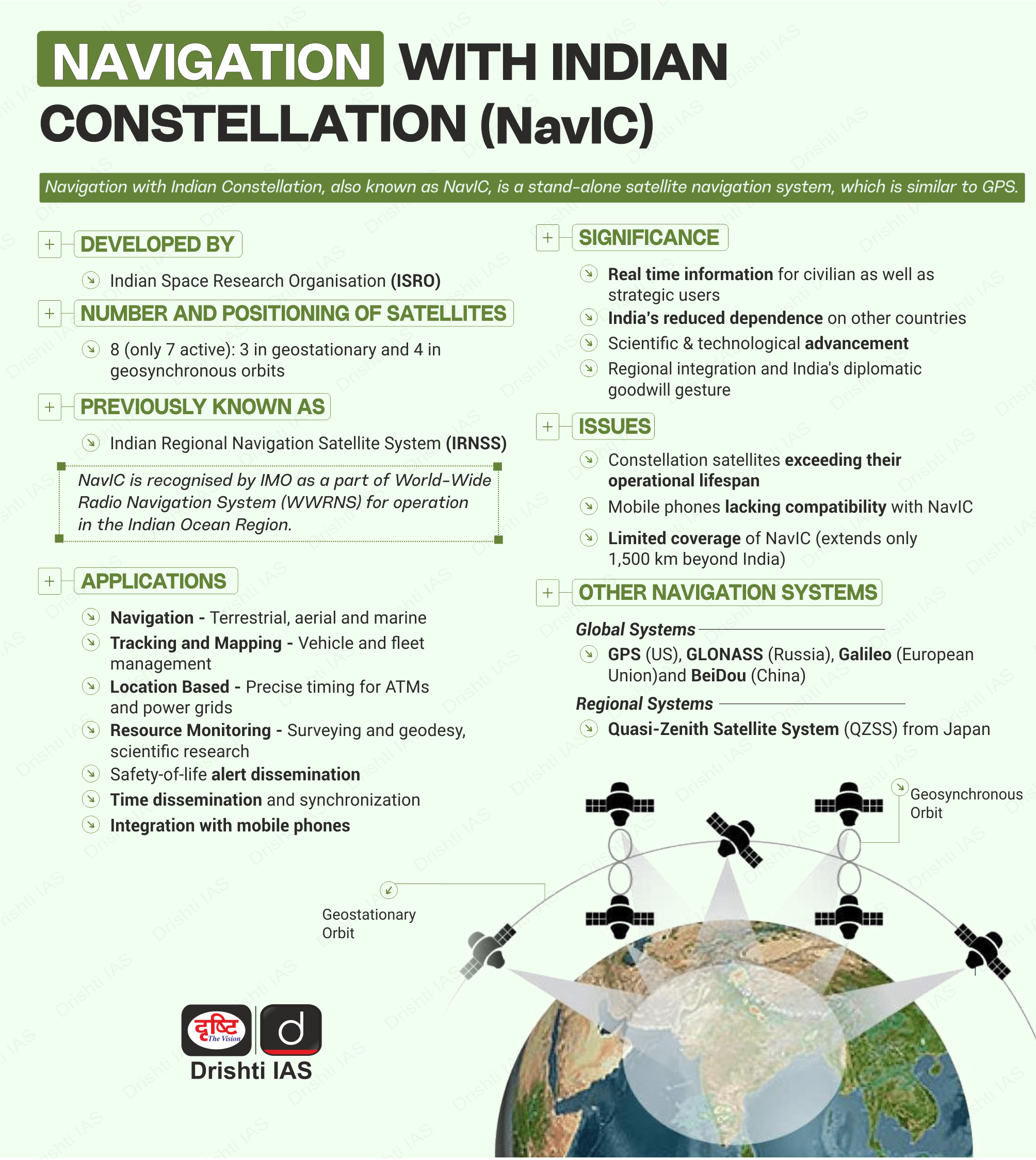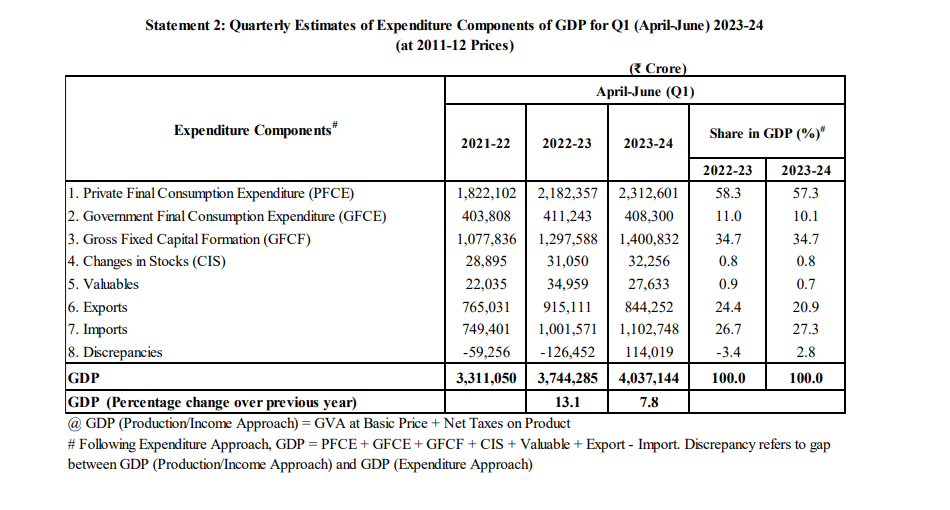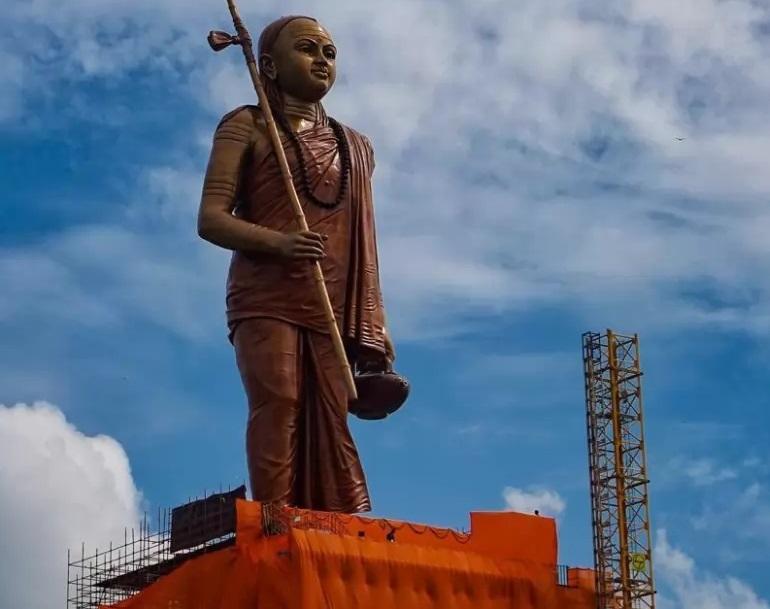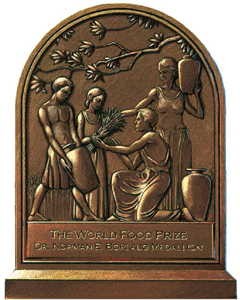Infographics
Agriculture
The Phosphorus Problem
For Prelims: Phosphorus, Synthetic Fertilizers, Apatite, Cadmium Contamination, Precision agriculture, PM-PRANAM.
For Mains: Contemporary Challenges Surrounding Phosphorus, Potential Strategies for Managing Phosphorus Usage.
Why in News?
The global phosphorus problem is gaining attention. With limited phosphorus reserves, contamination issues, and disruptions in the fertilizer market, finding sustainable solutions has become a critical priority.
What are the Major Facts Related to Phosphorus?
- About:
- Phosphorus is a chemical element with the symbol "P" and atomic number 15. It is an essential element for life and has various important properties and applications.
- Chemical Properties:
- Phosphorus readily forms compounds with other elements, especially oxygen, forming various phosphates.
- It is highly reactive and can spontaneously combust in air, producing a white smoke.
- Phosphorus compounds are crucial in biology, as they are a fundamental component of DNA, RNA, and ATP (adenosine triphosphate).
- Natural Occurrence:
- Phosphorus is commonly found in the Earth's crust in the form of various phosphate minerals, such as apatite.
- Industrial Uses:
- Phosphorus compounds are used in the production of fertilizers, as they are necessary for plant growth.
- It is also used in detergents, where phosphate compounds help break down and remove stains.
- Phosphorus is utilized in the production of steel and other metallurgical processes.
- Phosphorus in India:
- India is deficient in Apatite (group of phosphate minerals) & Rock Phosphate availability.
- According to Indian Minerals Yearbook 2018, in case of apatite, the country is fully dependent upon imports, while the Rock Phosphate production is only from two states namely, Rajasthan and Madhya Pradesh.
- India is the world's largest importer of phosphorus, primarily sourcing it from West African deposits contaminated with cadmium.
- Paddy, a staple crop in India, is particularly prone to cadmium uptake, and Indian farmers extensively use fertilizers on paddy fields.
What is the Historical Evolution of Fertilization and Contemporary Challenges Surrounding Phosphorus?
- Historical Evolution:
- The issue of fertilizing land has plagued agriculture since its inception. Early agricultural societies recognized that repeated cultivation and harvest cycles depleted essential nutrients from the soil, diminishing crop yields.
- Indigenous communities devised various fertilization methods, including using fish remnants and bird droppings (guano).
- However, significant advancements in chemistry during the 19th century led to the creation of synthetic fertilizers and the identification of vital elements like nitrogen, phosphorus, and potassium.
- These elements laid the foundation for modern chemical fertilizers and played a pivotal role in boosting agricultural productivity during the Green Revolution of the mid-20th century.
- In the present scenario, there exists a multifaceted challenge involving phosphorus, a crucial component of fertilizers.
- The issue of fertilizing land has plagued agriculture since its inception. Early agricultural societies recognized that repeated cultivation and harvest cycles depleted essential nutrients from the soil, diminishing crop yields.
- Challenges Associated with Phosphorus:
- Limited Reserves and Cadmium Contamination:
- Phosphorus is scarce and primarily found in specific geological formations. This is a major geopolitical concern.
- Morocco and the Western Sahara region possess the world's largest phosphorus reserves, but these reserves contain cadmium, a harmful heavy metal that can accumulate in the kidneys of animals and humans when consumed.
- The extraction and removal of cadmium from phosphorus resources are costly processes.
- Cadmium-laden fertilizers can contaminate crops, leading to potential health risks, such as heart disease.
- Limited Reserves and Cadmium Contamination:
Note
Failing to eliminate cadmium from phosphorus sources carries the potential for a public health crisis. Conversely, the removal of cadmium could result in higher fertilizer expenses, introducing a complex trade-off between safeguarding public health and maintaining agricultural affordability.
- The European Union has introduced legislation to regulate cadmium levels in fertilizers.
- Market Disruptions and Associated Concerns:
- Out of all the countries, only six have significant reserves of cadmium-free phosphorus.
- Among them, China imposed export restrictions in 2020, and several EU nations stopped purchasing from Russia.
- Consequently, there has been a surge in demand for safe phosphorus.
- Among them, China imposed export restrictions in 2020, and several EU nations stopped purchasing from Russia.
- This is one of the factors behind Sri Lanka's decision to ban synthetic fertilizer imports in 2021 and shift to organic farming.
- However, this transition led to a sudden decline in crop yields, triggering a political and economic crisis in the country.
- Out of all the countries, only six have significant reserves of cadmium-free phosphorus.
- Phosphorus Overuse: Excessive fertilizer application leads to phosphorus runoff into water bodies. Excessive phosphorus promotes algal blooms, depleting oxygen in water bodies and causing fish deaths.
- Algal blooms can also be toxic to humans, leading to respiratory issues and other health problems.
- Energy Intensive Mining: Extracting and processing phosphate rock is energy-intensive, contributing to greenhouse gas emissions and environmental degradation.
What can be Potential Strategies for Managing Phosphorus Usage?
- Smart Agriculture and Precision Fertilization: Implement precision agriculture techniques that utilize sensor networks, AI, and data analytics to optimize phosphorus use on farms. This ensures that crops receive the exact amount of phosphorus they need, reducing excess runoff into water bodies.
- Union Budget 2023–24 launched the PM-PRANAM scheme to promote the balanced use of chemical and alternative fertilizers, generating awareness of regenerative agriculture (RA).
- Phosphorus Recovery from Sewage and Waste: There is a need to develop advanced technologies for efficient phosphorus recovery from sewage and various waste streams.
- This could include using innovative filtration, precipitation, and ion-exchange processes to extract and recycle phosphorus for use in fertilizers or other applications.
- Example: Companies like EasyMining are retrofitting sewage treatment plants to recover high-quality phosphorus products.
- Circular Phosphorus Economy: There is a need to establish a circular economy for phosphorus, where products containing phosphorus are designed for easy recovery and recycling, reducing the need for mining and reducing environmental impact.
- Global Phosphorus Management Framework: There is a need to develop an international framework for phosphorus management, similar to global climate agreements. This would promote collaboration and coordinated efforts to address phosphorus concerns on a global scale.
UPSC Civil Services Examination, Previous Year Question
Q. With reference to chemical fertilizers in India, consider the following statements: (2020)
- At present, the retail price of chemical fertilizers is market-driven and not administered by the Government.
- Ammonia, which is an input of urea, is produced from natural gas.
- Sulphur, which is a raw material for phosphoric acid fertilizer, is a by-product of oil refineries.
Which of the statements given above is/are correct?
(a) 1 only
(b) 2 and 3 only
(c) 2 only
(d) 1, 2 and 3
Ans: B
Exp:
- The Government of India subsidizes fertilizers to ensure that fertilizers are easily available to farmers and the country remains self-sufficient in agriculture production. The same has been achieved largely by controlling the price of fertilizer and the amount of production. Hence, statement 1 is not correct.
- Ammonia (NH3) has been synthesized from natural gas. In this process, natural gas molecules are reduced to carbon and hydrogen. The hydrogen is then purified and reacted with nitrogen to produce ammonia. This synthetic ammonia is used as fertilizer, either directly as ammonia or indirectly after synthesis as urea, ammonium nitrate, and monoammonium or diammonium phosphates. Hence, statement 2 is correct.
- Sulfur is a major by-product of oil refining and gas processing. Most crude oil grades contain some sulfur, most of which must be removed during the refining process to meet strict sulfur content limits in refined products. This is done through hydrotreating and results in production of H2S gas, which is converted into elemental sulfur. Sulfur can also be mined from underground, naturally-occurring deposits, but this is more costly than sourcing from oil and gas and has largely been discontinued. Sulfuric acid is used in the production of both Monoammonium Phosphate (MAP) and Diammonium Phosphate (DAP). Hence, statement 3 is correct.
- Therefore, option B is the correct answer.


Biodiversity & Environment
Climate Ambition Summit 2023
For Prelims: Climate Ambition Summit, Paris Agreement, India's Climate Commitments
For Mains: Climate commitments made by India, Significance of international climate summits in advancing global climate action and cooperation.
Why in News?
The United Nations Climate Ambition Summit (CAS) held in United Nations Headquarters, New York on 20th September 2023, aimed to accelerate climate action as a prelude to the 28th Conference of Parties (COP28) to the United Nations Framework Convention on Climate Change(UNFCCC).
- However, China, the US and India , who collectively account for about 42% of global greenhouse gas emissions and are the top three emitters in that order were all absent from the CAS.
What is the Climate Ambition Summit (CAS)?
- About:
- The CAS is a prominent international event aimed at addressing the pressing issue of climate change.
- The CAS is designed to showcase “first mover and doer” leaders from government, business, finance, local authorities, and civil society who came with credible actions, policies and plans – and not just pledges – to accelerate the decarbonization of the global economy and deliver climate justice.
- The central aim of the CAS is to uphold the Paris Agreement's 1.5°C temperature limit, which seeks to prevent severe climate consequences by capping global warming at 1.5°C above pre-industrial levels.
- Participants at the Summit:
- A total of 34 states and 7 institutions had speaking slots, including India's neighbouring countries Sri Lanka, Nepal, and Pakistan, as well as emerging economies like South Africa and Brazil.
- Key players such as the European Union, Germany, France, and Canada also addressed the audience.
- Criteria for Participation:
- Countries were required to present updated pre-2030 Nationally Determined Contributions (NDCs), net-zero targets, and energy transition plans.
- Commitments to no new coal, oil, and gas projects, fossil fuel phase-out plans, and ambitious renewable energy targets were expected.
- Countries were urged to pledge to the Green Climate Fund and provide economy-wide plans for adaptation and resilience.
- Highlights of the Summit:
- Updated Climate Goals:
- Brazil pledged to reinstate its original 2015 climate goals, emphasizing the need for more ambitious measures and a transition away from fossil fuels.
- Nepal aimed for Net Zero emissions by 2045 instead of 2050, while Thailand targeted Net Zero by 2050, and Portugal set a carbon-neutral goal for 2045.
- All G-20 governments were asked to commit to presenting more ambitious NDCs featuring absolute emissions cuts by 2025.
- The summit emphasized the need to deliver climate justice, particularly to communities on the front lines of the climate crisis who are disproportionately affected.
- Other Announcements:
- Canada, which was one of the largest expanders of fossil fuels in 2022, announced the development of an emissions cap framework for the oil and gas sector.
- The EU and Canada call for global carbon pricing to cover at least 60% of emissions.
- Current carbon pricing mechanisms cover only 23% of emissions, generating USD 95 billion.
- In another development, Germany announced the launch of the International Climate Club, which it will co-chair with Chile, aiming to decarbonise industrial sectors and scale up green growth.
- The CAS highlighted the importance of comprehensive plans addressing adaptation and resilience across entire economies.
- Updated Climate Goals:
Paris Climate Accord
- Legal status: It is a legally binding international treaty on climate change.
- Adoption: It was adopted by 196 countries at the Conference of the Parties COP 21 in Paris in December 2015.
- Goal: To limit global warming to well below 2° Celsius, and preferably limit it to 1.5° Celsius, compared to pre-industrial levels.
- Objective: To achieve the long-term temperature goal, countries aim to reach global peaking of greenhouse gas emissions as soon as possible to achieve a climate-neutral world by mid-century.
- India is a signatory to the Paris Agreement. India reaffirmed its commitment to the agreement in August 2022 by submitting an updated NDC to the UNFCCC. The NDC outlines India's goals for 2021–2030.
What are India's Climate Commitments?
- In 2022, India updated its climate pledges to reduce emissions intensity by 45% from 2005 levels by 2030. This is a 10% increase from its previous 2016 pledge. The updated pledge is part of India's NDCs.
- India sets 2030 target to produce 50% of its energy need through non-fossil fuels.
- India aimed to create an additional carbon sink of 2.5 to 3 billion tonnes of CO2-equivalent by 2030.
- India pledged to achieve net-zero emissions by 2070.
UPSC Civil Services Examination, Previous Year Question (PYQ)
Prelims
Q. With reference to ‘Global Climate Change Alliance’, which of the following statements is/are correct? (2017)
- It is an initiative of the European Union.
- It provides technical and financial support to targeted developing countries to integrate climate change into their development policies and budgets.
- It is coordinated by the World Resources Institute (WRI) and the World Business Council for Sustainable Development (WBCSD).
Select the correct answer using the code given below:
(a) 1 and 2 only
(b) 3 only
(c) 2 and 3 only
(d) 1, 2 and 3
Ans: (a)
Mains
Q.Describe the major outcomes of the 26th session of the Conference of the Parties (COP) to the United Nations Framework Convention on Climate Change (UNFCCC). What are the commitments made by India in this conference? (2021).
Q. ‘Climate change’ is a global problem. How India will be affected by climate change? How Himalayan and coastal states of India will be affected by climate change? (2017).


Indian Economy
Concerns Related to India’s GDP Data
For Prelims: GDP (Gross Domestic Product), Gross Fixed Capital Formation, Purchasing Managers’ Indices, Bank Credit Growth, Index of Industrial Production (IIP).
For Mains: Concerns Related to India’s GDP Data, Calculations Methods For GDP in India.
Why in the News?
Recently, the Ministry of Finance has addressed concerns regarding the credibility of Indian GDP (Gross Domestic Product) data, particularly in light of a 7.8% increase in the first quarter of FY 2023-24.
- Several experts have pointed out discrepancy in India’s GDP statistics, which present a positive image of economic growth on billboards, while underlying issues such as rising inequalities, job scarcity, and a decline in manufacturing jobs persist.
What are the Concerns Raised with Respect to GDP Numbers?
- Discrepancies in GDP Calculation:
- An analysis of the GDP expenditure components reveals a concerning trend where most elements have decreased as a percentage of GDP.
- This includes private consumption, government spending, valuables, and exports.
- Imports have slightly increased, while Gross Fixed Capital Formation (investment in assets) and Change in Stocks (inventory changes) have remained stable.
- Therefore, there is an unexplained gap in the GDP calculation, which raises questions about the accuracy of the reported economic data.
- An analysis of the GDP expenditure components reveals a concerning trend where most elements have decreased as a percentage of GDP.
- Dual GDP Calculation Methods:
- India's GDP is calculated using two distinct methods: Economic activity (at factor cost) and Expenditure (at market prices).
- The factor cost method assesses the performance of eight different industries. The following eight industry sectors are considered in this cost:
- Agriculture, forestry, and fishing,
- Mining and quarrying,
- Manufacturing,
- Electricity, gas, water supply, and other utility services,
- Construction,
- Trade, hotels, transport, communication, and broadcasting,
- Financial, real estate, and professional services,
- Public administration, defense, and other services
- The expenditure-based method indicates how different areas of the economy are performing, such as trade, investments, and personal consumption.
- The factor cost method assesses the performance of eight different industries. The following eight industry sectors are considered in this cost:
- The differences between these methods may lead to variations in GDP figures.
- India's GDP is calculated using two distinct methods: Economic activity (at factor cost) and Expenditure (at market prices).
- Impact on Public Perception:
- Experts express concern that presenting an overly positive image of economic growth through GDP figures can mask the economic struggles and challenges faced by a significant portion of the population.
- This can impact public perception and policy decisions.
- Outdated Data Sets and Delayed Census:
- One of the major concerns is the usage of outdated data sets in the calculation of GDP, which may not accurately reflect the current economic scenario.
- Additionally, delays in conducting the census contribute to potential inaccuracies in economic assessments.
- There are concerns that the methods employed may not effectively capture the complex and evolving economic landscape, leading to potentially skewed GDP figures.
- Allegations of Government Interference:
- Allegations of government interference in the calculation and release of GDP figures have surfaced.
- Experts worry that political motivations might influence the presentation of economic data, impacting its accuracy and reliability.
How Has the Government Addressed the Issues Raised by the Experts?
- Credibility of Indian GDP Data:
- The Finance Ministry refuted doubts about the credibility of Indian GDP data, clarifying that it is not seasonally adjusted and is finalized three years later.
- This implies that relying solely on GDP indicators to assess underlying economic activity is misleading.
- Need for Comprehensive Analysis:
- The Ministry urged critics to consider various growth indicators, such as Purchasing Managers’ Indices, Bank Credit Growth, and consumption patterns, to form a well-rounded view of the economic activity.
- Underestimation of Growth Numbers:
- The Ministry argued that India's growth numbers might actually underestimate the economic reality, citing the Index of Industrial Production (IIP) as an example where reported manufacturing growth is lower than what companies are indicating.
- Nominal vs. Real GDP Growth:
- Addressing concerns about nominal GDP growth being lower than real GDP growth, the Ministry explained that India's GDP deflator, dominated by the Wholesale Price Index (WPI), is affected by various factors and will normalize in the coming months.
- Income Approach for GDP Calculation:
- The Ministry highlighted that India consistently uses the Income Approach for calculating GDP growth and does not switch between approaches based on favorability, dismissing arguments that favor nominal GDP growth.
What is GDP?
- About:
- GDP is the gross valuation of all the goods and services generated within a country's borders for a specific period, typically one financial year.
- One can identify a country's development and economic progress from its GDP.
- The percentage growth of GDP over a quarter is taken as a standard growth of the economy.
- As per the reports by International Monetary Fund (IMF), India is among the top 10 countries in the world based on the nominal GDP in 2023.
- GDP is the gross valuation of all the goods and services generated within a country's borders for a specific period, typically one financial year.
- Types of GDP:
- Real GDP:
- Real GDP is measured with respect to a base year. It is adjusted to inflation and hence is also known as inflation-corrected GDP or current price.
- For example, the base year for calculating India's Real GDP is 2011- 12. Earlier, it used to be 2004- 05.
- It is considered to be a more precise representation of GDP as it considers the actual income of individual residents after adjusting to the price fixed for a base year.
- Real GDP is measured with respect to a base year. It is adjusted to inflation and hence is also known as inflation-corrected GDP or current price.
- Nominal GDP:
- Nominal GDP is assessed using prevailing market prices and does not consider inflation or deflation.
- From the government's perspective, Nominal GDP is a more accurate reflection of economic growth as it affects the citizens directly.
- Real GDP:
- Calculation of GDP:
- Expenditure Method: This approach takes into consideration the total expenditure incurred by all individuals in one economy for Goods and Services.
- GDP (as per expenditure method) = C + I + G + (X-IM)
- where, C: Consumption expenditure, I: Investment expenditure, G: Government spending and (X-IM): Exports minus imports, that is, net exports.
- Output Method: This approach is used to determine the market value of all the services and products produced within a country.
- This method helps eliminate any difference in GDP measurement due to price level fluctuations.
- Income Method: This approach considers the gross income earned by various factors of production, like capital and labour, within the boundaries of a country.
- This is a sum of expenditure made by companies on their workforce.
- GDP calculated based on this approach is known as GDI or Gross Domestic Income.
- GDP ( through Income Method) = Wages + Rent + Interest + Profit
- Expenditure Method: This approach takes into consideration the total expenditure incurred by all individuals in one economy for Goods and Services.
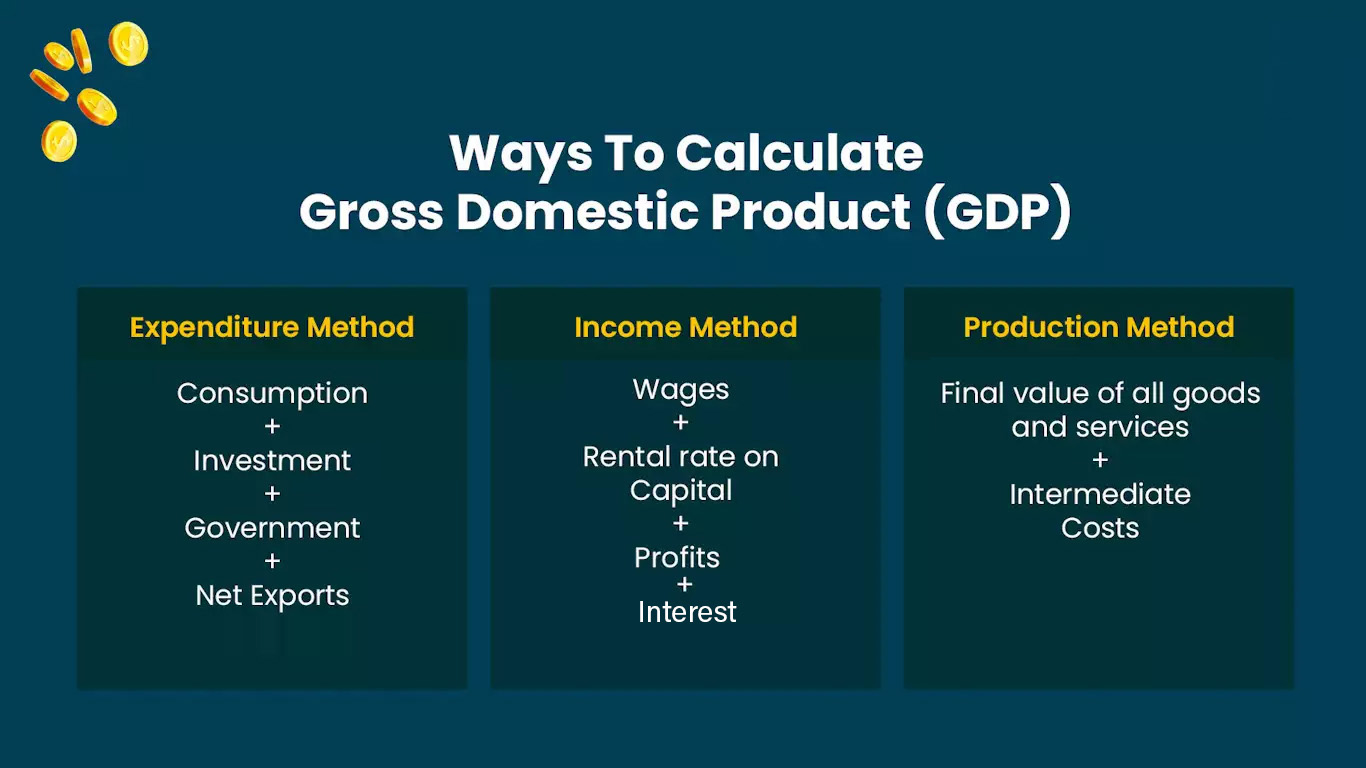 |
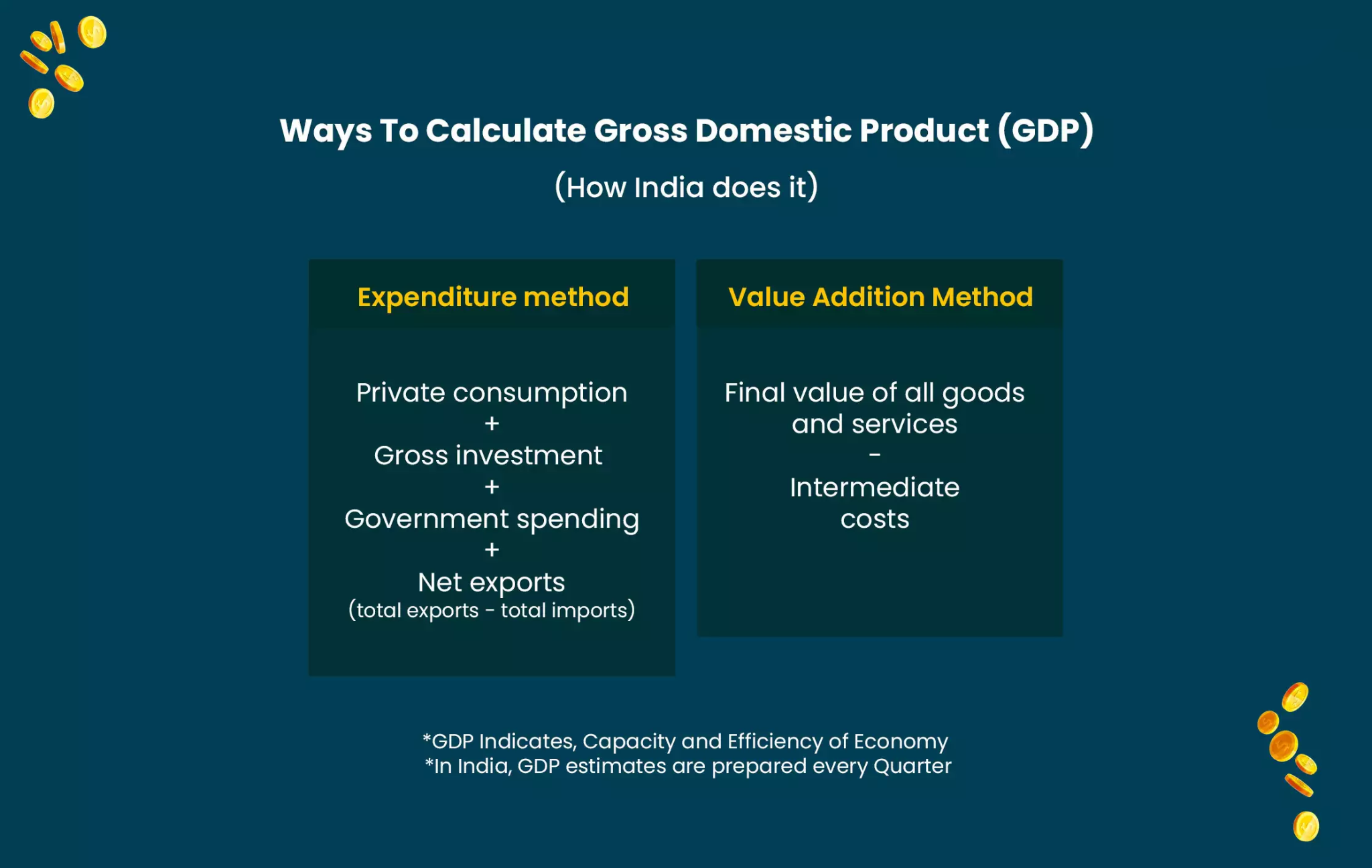 |
What Are the Limitations Of GDP?
- GDP does not include non-market transactions that positively impact productivity, such as domestic, voluntary, or other participations. Also, it doesn't take into account goods produced for private consumption.
- India is one of those countries where unequal income distribution is a prime discrepancy in its economy. GDP doesn’t reflect that.
- One cannot determine the standard of living of a country from its GDP.
- India is the best example of it. It has a high GDP but a relatively low standard of living.
- Most importantly, GDP doesn't reflect how industries affect the environment and social well-being.
- The government launched Green Gross Domestic Product (Green GDP) to address this issue.
Conclusion
- The Ministry of Finance emphasized the importance of considering various economic indicators and higher frequency data to form a comprehensive view of economic activity.
- It urged critics to refrain from selectively using data and maintain a nuanced understanding of the Indian economy.
UPSC Civil Services Examination, Previous Year Questions (PYQs)
Q. With reference to Indian economy, consider the following statements: (2015)
- The rate of growth of Real Gross Domestic Product has steadily increased in the last decade.
- The Gross Domestic Product at market prices (in rupees) has steadily increased in the last decade.
Which of the statements given above is/are correct?
(a) 1 only
(b) 2 only
(c) Both 1 and 2
(d) Neither 1 nor 2
Ans: (b)


Indian Heritage & Culture
India's Maritime History
For Prelims: Tankai method, Project Mausam, Lothal, Jataka Tales, Jawaharlal Nehru Port Trust, Maritime Vision 2030.
For Mains: India's History of Maritime Trade, Current Status of Maritime Transport in India.
Why in News?
A 21-meter-long ship, constructed using ancient stitched shipbuilding method (Tankai method) is set to embark on a voyage from Odisha to Bali in Indonesia in November 2025.
- Manned by a crew from the Indian Navy, this project not only showcases India's maritime tradition but also sheds light on its seafaring history.
- This initiative is also in harmony with the Ministry of Culture's Project Mausam, which seeks to reestablish maritime cultural ties and foster cultural understanding among the 39 countries bordering the Indian Ocean.
What is India's History of Maritime Trade?
- Early Evidence of Maritime Trade:
- Indus Valley and Mesopotamia: The earliest known instances of people from the Indian subcontinent engaging in sea trade date back to around 3300-1300 BCE.
- The dock at Lothal (in present-day Gujarat), shows the civilisation’s deep understanding of the workings of tides and winds.
- Vedic and Buddhist References: The Vedas, composed between 1500-500 BCE, contain vivid tales of seafaring.
- Additionally, the Jataka Tales and Tamil Sangam literature, spanning from 300 BCE to 400 CE, offer further insights into ancient Indian seafaring activities.
- Indus Valley and Mesopotamia: The earliest known instances of people from the Indian subcontinent engaging in sea trade date back to around 3300-1300 BCE.
- Intensification of Maritime Activity: By the 1st century BCE, movement through the deep seas intensified, partly driven by the Roman Empire's demand for Eastern commodities.
- Harnessing the power of monsoon winds became crucial for completing long journeys, and Roman commerce played a significant role in promoting such voyages.
- Romans acquired products from the Coromandel Coast – such as horses, pearls, and spices.
- Diverse Boat-Building Traditions: Ancient Indian boat-building traditions were diverse and included the coir-sewn tradition of the Arabian Sea, the jong tradition of Southeast Asia, and the Austronesian tradition of outrigger boats.
- These traditions often employed stitching instead of nails for construction.
- Different types of wood were used for shipbuilding, with mangrove wood being ideal for dowels and teak for planks, keels, stem, and stern posts.
- Evidence of these wood usages can be found in coastal communities and archaeological sites across the Indian Ocean.
- India as the Center of Trade: By the Common Era, the Indian Ocean had become a vibrant "trade lake," with India at its heart:
- Western Trade Route: India connected to Europe through the Middle East and Africa, with ports like Bharuch and Muziris serving as vital trade hubs.
- Eastern Trade Route: Evidence of Indian artifacts in Hepu, China, dating back to the 3rd century BCE, suggests a maritime route linking India to China and Malaysia.
- Tamralipti in Bengal played a significant role in this trade.
- These maritime networks facilitated the movement of people from various backgrounds, fostering cultural exchanges.
- Artifacts of Indian origin have been discovered as far as Berenike in Egypt, including Hindu gods' representations and inscriptions in Sanskrit.
What is the Current Status of Maritime Transport in India?
- India is the 16th largest maritime country in the world. Currently, Maritime transport in India handles 95% of the trade by volume and 68% by value.
- India is one of the world's top 5 ship recycling countries and holds 30% share in the global ship recycling market.
- India also owns over 30% global market share in the ship-breaking industry and is home to the largest ship-breaking facility in the world at Alang, Gujarat.
- As of December 2021, India had a fleet strength with a Gross tonnage (GT) of 13,011 thousand. However, the Indian fleet is just 1.2% of the world's fleet in terms of capacity and carries only 7.8% (for 2018-19) of India’s EXIM trade (Economic Survey 2021-2022).
- In 2017, the government launched the ambitious Sagar Mala Program with the vision of port-led development and growth of logistics-intensive industries.
- India has currently 12 major and 200 non-major/intermediate ports (under state government administration).
- Jawaharlal Nehru Port Trust is the largest major port in India, while Mudra is the largest private port.
- The Maritime India Vision 2030 has identified over 150 initiatives to boost the Indian maritime sector.


Important Facts For Prelims
Statue of Adi Shankaracharya
Why in News?
Chief Minister of Madhya Pradesh (M.P) unveiled the 108 feet high 'Statue of Oneness' of Adi Shankaracharya on Mandhata mountain at Omkareshwar in Khandwa district, M.P and laid the foundation stone of Advaita Lok.
Why is the Mandhata Consider Significant?
- The Mandhata island, nestled on the Narmada River, is home to two of the 12 Jyotirlingas – Omkareshwara (located on the south side of the island) and Amareshwara.
- The island is dotted with Shaivite, Vaisnavite, and Jain temples dating back to the 14th and 18th centuries.
- The name ‘Omkareshwar’ is derived from the shape of the island, which resembles the sacred syllable ‘Om’, and its name means ‘the Lord of Omkara’.
Who was Adi Shankaracharya?
- About:
- Known as Adi Shankara(788–820 CE), born at Kaladi near Kochi, Kerala.
- Took Samadhi at the age of 33, at Kedar tirth.
- He was a devotee of Shiva.
- He is said to have arrived at Omkareshwar as a young monk, where he encountered his Guru Govind Bhagwadpad.
- Resided in the sacred city for four years, and received his education .
- He departed Omkareshwar at the age of 12 and embarked on a journey across the nation, disseminating the teachings of Advaita Vedanta philosophy and elucidating its principles to the people.
- Propounded the Doctrine of Advaita (Monism) and wrote many commentaries on the Vedic canon (Upanishads, Brahma Sutras and Bhagavad Gita) in Sanskrit.
- He was opposed to Buddhist philosophers.
- Known as Adi Shankara(788–820 CE), born at Kaladi near Kochi, Kerala.
- Major Work:
- Brahmasutrabhasya (Bhashya or commentary on the Brahma Sutra).
- Bhajagovinda Stotra.
- Nirvana Shatakam.
- Prakaran Granths.
- Other Contributions:
- Was responsible for reviving Hinduism in India to a great extent when Buddhism was gaining popularity.
- Established four Mathas in the four corners of India at Sringeri, Puri, Dwaraka and Badrinath– for propagation of Sanathana Dharma
What is Advaita Vedanta ?
- It articulates a philosophical position of radical nondualism, a revisionary worldview which it derives from the ancient Upanishadic texts.
- According to Advaita Vedantins, the Upanishads reveal a fundamental principle of nonduality termed ‘brahman’, which is the reality of all things.
- Advaitins understand brahman as transcending individuality and empirical plurality.
- They seek to establish that the essential core of one’s self (atman) is brahman.
- The fundamental thrust of Advaita Vedanta is that the atman is pure non-intentional consciousness.
- It is one without a second, nondual, infinite existence, and numerically identical with brahman.
Other Famous Statue
- Previously, Prime Minister (PM) of India inaugurated the Statue of Equality on the outskirts of Hyderabad to commemorate the 11th-century Bhakti saint Sri Ramanujacharya on his 1,000th birth anniversary.
- In 2018, PM inaugurated the Statue of Unity in Gujarat's Kevadia in memory of former deputy Prime Minister Sardar Vallabhbhai Patel.


Important Facts For Prelims
Five Eyes Alliance
Why in News?
Since the Canadian Prime Minister alleged that the Indian Government may have “potential links” to the killing of a Sikh separatist leader and Khalistan Movement proponent in Canada, the ties between the two countries are under strain; where his allegations are backed by reports of Five Eyes Alliance.
What is Five Eyes Alliance?
- About:
- The Five Eyes is an intelligence alliance comprising nations including Australia, Canada, New Zealand, the United Kingdom and the US.
- These countries are parties to the multilateral UK-USA Agreement, a treaty for joint cooperation in signals intelligence.
- Features:
- These partner nations exchange a wide spectrum of intelligence within one of the world's most tightly-knit multilateral agreements as part of the collaboration.
- Following its origin, the agency later enlarged its core group to ‘Nine Eyes’ and 14 Eyes alliances as well, encompassing more countries as security partners.
- The ‘Nine Eyes’ group expands to cover the Netherlands, Denmark, France and Norway, whereas the 14 Eyes bloc further includes Belgium, Italy, Germany, Spain and Sweden.
Why was the Five Eyes Alliance Formed?
- The alliance’s origins can be traced back to the Second World War. The UK and the US decided to share intelligence after successfully breaking German and Japanese codes, respectively.
- In 1943, the Britain-USA (BRUSA) agreement laid the foundations for what would become the UK-USA (UKUSA) agreement.
- BRUSA was signed to share intelligence information between the two countries to support US forces in Europe
- Following this, the UKUSA (UK-USA) was signed in 1946. Canada joined it in 1949, and New Zealand and Australia did so in 1956, forming the alliance.
- The Agreement was not officially acknowledged though its existence was known about from the 1980s. But in 2010, the UKUSA agreement files were released.
How does the Five Eyes Alliance Work?
- Countries often engage with each other on matters of intelligence gathering and security.
- In recent years, common interests, such as balancing the rise of China, have led to a closer alignment among the Five Eyes countries.
- Their closeness has also been attributed to a common language and mutual trust built over decades of association.
- In 2016, the Five Eyes Intelligence Oversight and Review Council came into being. It includes the non-political intelligence oversight, review, and security entities of the Five Eyes countries.
How could Five Eyes Play a Role in the Current India-Canada Issue?
- Countries like the US, the UK and Australia especially are seen as close to India. They also have significant Indian and Indian-origin populations within them, similar to Canada.
- They have also seen some instances of pro-Khalistan activities in the last few years. But due to their historical closeness to Canada and the alliance on one hand, and India,an emerging global power on the other, outright support for India or Canada is unlikely.
- Given the state of ties, these countries, particularly the US, could play a mediating role in the issue once they have clear intelligence and information on the matter.


Important Facts For Prelims
Norman E. Borlaug Award
Why in News?
Indian agriculture scientist Dr. Swati Nayak, affectionately known as "Bihana Didi" or "Seed Lady" by local communities in Odisha, has been honored with the Norman E. Borlaug Award for 2023.
- She became the third Indian to receive this prestigious award after Aditi Mukherji (2012) and Mahalingam Govindaraj (2022), recognizing her remarkable contributions to agriculture, particularly in the realm of drought-tolerant rice varieties.
What is Norman E. Borlaug Award?
- The award is endowed by the Rockefeller Foundation, the award is presented every October in Des Moines, Iowa, US by the World Food Prize Foundation to honor individuals under the age of 40 who have achieved remarkable, science-based accomplishments in international agriculture and food production.
- The award is named after Norman E. Borlaug, the father of the Green Revolution and the 1970 Nobel Peace Prize laureate.
- The award diploma incorporates the image of Dr. Norman E. Borlaug at work in the fields of Mexico and a cash prize of USD 10,000.
What are the Contributions of Swati Nayak?
- Dr. Swati Nayak Introduced drought-tolerant Shahabhagi Dhan rice variety in Odisha. It brought about a major change in rainfed areas. The variety became an integral element of every farmer family’s diet and crop rotation.
- Many climate-resilient rice varieties have been successfully deployed in India, Bangladesh, and Nepal through her diligent strategy, partnerships, and unique positioning models.
- She is recognised for her innovative approach to engaging smallholder farmers in demand-driven rice seed systems, from testing and deployment to equitable access and adoption of climate-resilient and nutritious rice varieties.
- Pioneered a comprehensive blueprint for the first-ever dedicated Indian government initiative for women farmers, benefitting four million women farmers.


Rapid Fire
Rapid Fire Current Affairs
NASA’s First Asteroid Samples Land on Earth
- The NASA’s Origins, Spectral Interpretation, Resource Identification, and Security-Regolith Explorer (OSIRIS-REx) spacecraft, launched on 8th September 2016, has successfully delivered the first asteroid samples from the near-Earth asteroid Bennu (formerly 1999 RQ36) to Earth after a seven-year journey, bringing valuable 4.5 billion-year-old samples.
- The Osiris-Rex sample capsule was released during an Earth flyby, landing safely in the Utah desert, United States preserving the asteroid samples.
- Scientists estimate the capsule has at least a cupful of debris from the carbon-rich asteroid Bennu.
- The samples are expected to provide insights into the formation of Earth and life 4.5 billion years ago.
- Osiris-Rex will continue its mission by studying another asteroid, Apophis, which it will reach in 2029.
Read more: NASA's OSIRIS-REx Mission
Philippine Officials Challenge China's South China Sea Barrier
- Philippine officials vowed to remove China's coast guard-installed 300-meter-long floating barrier in the disputed Scarborough Shoal of the South China Sea. They called it "illegal and illegitimate," highlighting the violation of Filipino fishermen's rights.
- The Philippines asserts that Scarborough Shoal lies within its United Nations Convention on the Law of the Sea(UNCLOS)-defined exclusive economic zone, a claim upheld in a 2016 arbitration decision that China rejected.
- This dispute adds to long-standing territorial tensions in the South China Sea, a potential Asian geopolitical hotspot.
- The South China Sea, an arm of the Western Pacific Ocean, is bordered by Brunei, Cambodia, China, Indonesia, Malaysia, the Philippines, Singapore, Taiwan, Thailand, and Vietnam.
- It connects to the East China Sea via the Taiwan Strait and the Philippine Sea through the Luzon Strait.
- It encompasses the Spratly Islands, Paracel Islands, Pratas Islands, Macclesfield Bank, and Scarborough Shoal.
Read more: South China Sea
Maharashtra’s Ephemerals
In parts of Maharashtra, a fascinating botanical phenomenon unfolds as certain plant species, known as ephemerals, patiently await the monsoon season to burst into bloom.
- These ephemerals come in two forms: annual and perennial.
- Annual ephemerals create new individuals each year, showcasing their beauty for a brief period before forming seeds and lying dormant until the next monsoon.
- Perennials, on the other hand, have a continuous presence underground, with tubers or bulbs supporting their existence.
- From ground orchids to lilies, wild yam, and Indian squill, these ephemerals play a crucial role as nectar and pollen sources for native pollinators while also preserving essential soil and water dynamics.
Monsoon Withdrawal from India Delayed
The southwest monsoon in India has started to withdraw, eight days later than the normal date, according to the India Meteorological Department. 2023 marks the 13th consecutive delayed withdrawal of the monsoon.
- The southwest monsoon typically starts over Kerala by 1st June and covers the entire country by 8th July.
- It begins retreating from northwest India around September 17 and withdraws completely by October 15.
- A delayed monsoon retreat leads to a longer rainy season, which can have a significant impact on agricultural production, especially for northwest India where monsoon rainfall is crucial for Rabi crop production.
Read more: Southwest monsoon



